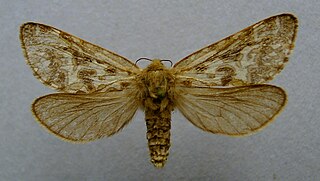
The Hepialidae are a family of insects in the lepidopteran order. Moths of this family are often referred to as swift moths or ghost moths.

Aenetus is a genus of moths of the family Hepialidae. There are 24 described species found in Indonesia, New Guinea, New Caledonia, Australia and New Zealand. Most species have green or blue forewings and reddish hindwings, but some are predominantly brown or white. The larvae feed in the trunks of living trees, burrowing horizontally into the trunk, then vertically down.

Aoraia is a genus of moths of the family Hepialidae. There are 13 described species, all endemic to New Zealand. The type species of this genus is Porina dinodes Meyrick, 1890. This genus contains some large species with a wingspan of up to 150 mm.
Bipectilus is a genus of moths of the family Hepialidae. There are eight described species in the genus, distributed through China, Nepal and Vietnam.
Callipielus is a genus of moths of the family Hepialidae. There are 10 described species, all found in southern South America.
Dalaca is a genus of moths of the family Hepialidae. There are 23 described species found throughout South America as far north as Panama. The larvae feed on grasses.

Fraus is a genus of moths of the family Hepialidae. There are 25 described species, all endemic to Australia.

Gazoryctra is a genus of moths of the family Hepialidae. There are 14 described species found in Eurasia, Canada and the United States.
Pfitzneriana is a genus of moths of the family Hepialidae. There are four described species, all found in South America.

Pharmacis is a genus of moths of the family Hepialidae. There are eight described species found in Eurasia.

Phassodes is a moth genus of the family Hepialidae. As of 2018, it is monospecific, consisting of the sole species Phassodes vitiensis; this species is very variable. It is found in Fiji and Samoa. The life cycle is unknown but the larva is presumed to feed underground on the roots of plants or decaying matter.

The orange swift or orange moth is a moth belonging to the family Hepialidae. The species was first described by Carl Linnaeus in 1761 and was previously placed in the genus Hepialus. It is distributed throughout Europe.

Dumbletonius characterifer is a species of moth of the family Hepialidae. It is endemic to New Zealand. It was first described by Francis Walker in 1865.

Dumbletonius unimaculata is a species of moth of the family Hepialidae. It is endemic to New Zealand. This species is host to the vegetable caterpillar fungus Ophiocordyceps robertsii.
Ahamus is a genus of moths of the family Hepialidae.

Buller's moth is a possibly extinct moth that is endemic to New Zealand. It is known from a single specimen caught in the Ruahine Range by Sir Walter Buller while on an expedition searching for the huia in the summer of 1867. Buller named it Porina mairi in honour of his brother-in-law Captain Gilbert Mair. Buller described the species as having a wingspan of almost 6 inches (150 mm). It is this wingspan that rules out the specimen being associated with species such as Dumbletonius characterifer.
Thitarodes shambalaensis is a species of moth of the family Hepialidae. It was described by Zhengyang Wang, along with Hailing Zhuang, Min Wang, and Naomi E. Pierce in 2019, and is known from Sichuan, China from the Tibetan Plateau, where it was found on the Yanzigou glacial valley, Mt. Gongga. It was differentiated as a new species using morphological and genetic evidence, including genome-wide SNP analysis and CO1 phylogeny. Notably, this species is a host for the caterpillar fungus Ophiocordyceps sinensis, which is economically important for its use in traditional herbal medicine. This fungus is in decline due to overharvesting and climate change. Species in the genus Thitarodes are largely unknown due to logistical difficulties in collecting adult, male specimens, correct identification of their genitalia, and lack of accessible holotypes.










